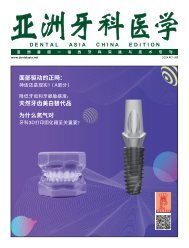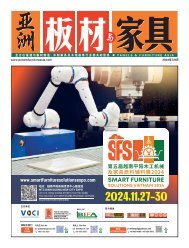Dental Asia May/June 2020
For more than two decades, Dental Asia is the premium journal in linking dental innovators and manufacturers to its rightful audience. We devote ourselves in showcasing the latest dental technology and share evidence-based clinical philosophies to serve as an educational platform to dental professionals. Our combined portfolio of print and digital media also allows us to reach a wider market and secure our position as the leading dental media in the Asia Pacific region while facilitating global interactions among our readers.
For more than two decades, Dental Asia is the premium journal in linking dental innovators
and manufacturers to its rightful audience. We devote ourselves in showcasing the latest dental technology and share evidence-based clinical philosophies to serve as an educational platform to dental professionals. Our combined portfolio of print and digital media also allows us to reach a wider market and secure our position as the leading dental media in the Asia Pacific region while facilitating global interactions among our readers.
You also want an ePaper? Increase the reach of your titles
YUMPU automatically turns print PDFs into web optimized ePapers that Google loves.
User Report<br />
Fast, Simple and Highly Sensitive:<br />
<strong>Dental</strong> Diagnosis with Digital Intraoral X-ray Imaging<br />
Digital dentistry has become the standard for dental<br />
care in Norway. In 1996, Norwegian dentist, Jan<br />
Kirkedam, started using storage plate systems for<br />
digital intraoral imaging and since 2003, he has been<br />
working with intraoral sensors. Depending on the<br />
patient’s case, he relies on both Dentsply Sirona X-ray systems –<br />
the storage plates with the Xios Scan unit, as well as the Xios XG<br />
Supreme Sensors.<br />
with storage plates – within one minute instead of two to three<br />
minutes,” said Dr. Kirkedam.<br />
Today, his first choice for intraoral imaging is Dentsply Sirona’s<br />
Xios XG Supreme sensor. “For me, it was a major technological<br />
breakthrough when the Xios XG Supreme came on the market in<br />
2015. Its image quality in terms of resolution, sharpness and the<br />
density of information really convinced me,” he explained.<br />
Dr. Kirkedam recalled, “To be honest, my initial motivation for<br />
starting with digital X-ray imaging in the mid-1990s was pure<br />
curiosity, combined with my high interest in technology. I wanted to<br />
be part of the technological evolution. Of course, the new storage<br />
plate’s advantages, such as the significantly reduced development<br />
time and the easier handling, were additional arguments in favour<br />
of the new X-ray systems.”<br />
His first choice today: the Xios XG Supreme sensors<br />
In 2003, he started with intraoral sensors. “Besides the fact that<br />
there was again this new piece of technology to explore, I adopted<br />
the intraoral sensors for two main reasons: Sensors require a<br />
much lower X-ray dose and I can take an X-ray even faster than<br />
In addition to its high resolution of 33.3 lp/mm and a pixel size of 15<br />
μm, the XIOS XG Supreme sensor is equipped with a special Cesium<br />
Iodide scintillator material to provide images with low noise and<br />
high contrast. Thanks to a dynamic focus capability, the sensor’s<br />
sharpness can be configured in four different ways depending on<br />
the particular case. Today, each of the six treatment rooms in Jan<br />
Kirkedam’s practice is equipped with Dentsply Sirona’s Xios sensor<br />
system. Additionally, his team can use a centralised Xios Scan unit<br />
for storage plates.<br />
Plate or sensor? – criteria to consider<br />
At Dr. Kirkedam’s practice, each dentist has his own imaging<br />
preferences. In almost every case, Dr. Kirkedam opts for the Xios XG<br />
48<br />
DENTAL ASIA MAY / JUNE <strong>2020</strong>


















